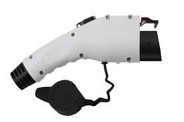Charging Cable Repair Service
All Prices Include VAT & UK Postage
Non-UK Orders must pay for additional postage





Charging Cable Repair Service
All Prices Include VAT & UK Postage
Non-UK Orders must pay for additional postage
(Please note that for tethered EVSE leads, the plug dust cap is not supplied.)
‘1P’ means single phase, ‘3P’ means three phase. *All* Type 1 cables are single phase only.
If you do not know how many phases your Type 2 cable/plug is, check the cable for embossing which should show something like this:
‘3G2.5mm2+2xG0.5mm2’ which translates as ‘3 gang (3 main conductors) of 2.5mm squared, cross sectional area, main conductors - L, N & E - plus 2 cores of 0.5mm squared signal conductors. In this case the cable is a single phase, 16A.
If the cable embossing shows ‘5G6.0mm2+1x0.5mm2’ it has FIVE main conductors - L1, L2, L3, N & E - and is, therefore, a 3 phase cable, 32A due to the much heavier 6.0mm2 main conductors.
Alternatively, please email me for a quotation.
Include photographs, please, of the damage and the control box (for ID purposes).
Please note: Goods will be returned using Royal Mail 2nd Class.
I am based on an island and all postage is subject to the whims of Poseidon - sometimes ‘the boat don’t sail’!
Cable Fault-Finding Guide
All there is in the way of ‘circuits’ in EV cable plugs is a microswitch and 2 resistors in the Type 1 plug and just one resistor in the Type 2 plug (schematic below - and in the name of clarity, I name cables after the direction of charging current flow - eg T2 > T1). The Type 2 circuit does fail but rarely. The Type 1 is more prone to faults as it has ‘moving parts’. I do stock replacement Type 1 plug microswitch/resistor assemblies as well as spare pins etc for all types of plug and socket but for Duosida/Dostar products only.
If you have a multimeter, check:
1/ Continuity present on all 4 conductors (L, N, E & CP) from one end to the other
2/ Type 2 male plug PP-PE resistance is correct at 680R for 16A cable or 220R for 32A cable +/- ~2R (16A cable has 2.5mm2 main conductors and 32A has 6.0mm2 ones).
3/ Type 1 plug latch correctly latches to EV socket with clean spring action across 100% of travel and there is adequate latch/receiver clearance (~0.5mm min). This means that after insertion, the latch (and button) return to exactly the same position relative to the Type 1 plug body when fully and correctly inserted as it is in when not plugged in - otherwise there is a danger that the microswitch will not switch correctly. The microswitch shorts out the 350R resistor leaving just 150R between PE and PP when the button is pressed. This is used by the EV to understand what ’state’ the plug/socket connection is in.
4/ Intermittent wire connection checked for by vigorous wiggling of cable along its length, especially at cable plug entry point(s).
5/ No obvious significant physical or heat damage to plugs, plug contacts or cable.
6/ No significant oxidation of plug contacts.
7/ Insides of both plugs checked for water ingress. You will need a Torx bit (or ‘Star - 6 ‘lobes’) to open those plugs that have screws (most OEM ones are sealed up, somewhat unsustainably, IMO, and generally cannot therefore be repaired) or Pentalobe bit (rarer and 5 ‘lobes’ in the screw head) usually size 15, some have the small ‘nipple’ in the bottom of the screw head meaning your driver bit needs the matching hole or it won’t work.
Fuller version:
The first thing you can check is for is any obvious sign of damage to the plug pins, either mechanical damage (eg bent or broken pins) or corrosion / the build of of ‘verdigris’ - the green-coloured oxidation of a copper-based metal. If this is present then it can interfere with the connection. This is most likely to appear on the CP pins. This is because, if the chargepoint is left on (ie energised from the mains) there is 12VDC present on the CP at all times. In damp/wet environments, a circuit can be set up between the CP and PE pins where water acts as the connection leading to galvanic corrosion of the CP pin.
Next the cable itself should be examined for signs of mechanical damage including a discontinuity in the shape of the cable. Commonly, if the cable is run over by a car, it ends up with a significant kink in it which may hide internal damage to the conductors especially the very thin CP one leading to a loss of or intermittent communications between the EV and chargepoint.
The first electrical test (using a very basic multimeter) you can easily do is to check for continuity from one plug to the other on each of the 4 conductors; L1, N, PE and CP all of which has a simple direct connection between the matching pins. So, set your multimeter to the ‘continuity' setting (touching the 2 probes together should make the multimeter beep). Then apply one probe to the matching pin at each end of the cable ie L1 to L1, etc and you should get a beep with each conductor (placing the 2 plugs facing you between your knees giving you both hands free works for me!).
The only thing to watch for (and, frankly, this is the most likely issue if your cable works sometimes) is an *intermittent* contact ie depending on the position of the cable relative to the plug (at both ends) you may get continuity or you may not. This is because depending on how the cable sits, if there is a damaged wire inside the cable, the broken ends may touch or they may not. The most likely failure point is where the cable enters either plug as this does much more sharp flexing than any other part of the cable.
Unfortunately, testing for an intermittent fault is quite difficult as ideally you need to have a good, steady connection between multimeter probes and pins whilst flexing the cable thoroughly all along its length (but especially at the points where the cable enters the 2 plugs). This is much more easily done with another pair of hands! Otherwise you need to insert something into the plugs which keeps a good contact with the multimeter probes whilst you do the flexing. I use probes with crocodile clip ends and insert a proper mating pin into each plug end to attache the crocodile clips to - this makes the connection very reliable and allows me to flex the cable to my heart's content.
The CP wire is much smaller than the others and so this is the most likely one to fail.
If you do not get full and constant continuity on each wire then there is a problem. Likewise, any significant resistance (greater than one or 2 ohm) on the conductors could cause problems. All the continuity tests should not give any more than one or 2 ohms of resistance.
The next likely issue is the failure of the circuit in both plugs that tells the EV (in the case of the larger female plug) and EVSE (charge-point - for the smaller male plug) what the current carry capacity of the cable is. This consists of a resistor wired between the PE (earth) pin and the ‘PP’ pin on each plug. For a 32A cable its value should be ~220R (220 ohms) and for 16A cable it should be 680R (some ‘granny charger’ cables have 1500R to limit the charging current to 10A). Using your multimeter in resistance mode, you should find it easy to check this. A few ohms out is OK but open circuit is an instant fail.
The CP pin on Type 2 male plugs and sockets is ~13mm shorter than all the other pins.
By all means send your defective cable to me for an assessment. See above for full details of my service.
Type 1 Plug & Socket
Type 2 Male Plug & Socket
Type 2 Female Plug & Socket
T2>T1 Cables (& Adaptors/Extensions)
Cable Repair Service
I can mend your charging lead should, for example, the cable need replacing...
Harry the Dog



Type 1 Plug
Type 2 Male Plug
Type 2 Female Plug




















EV charging cables are either ‘free’, ‘tethered‘ or ‘portable EVSE‘ types. The last is also known as a ‘Granny charger‘ or ‘Mode 2‘ cable.
All cables have a large special EV plug at each end; either a ‘Type 2’ (aka ‘Mennekes after the original German maker) or ‘Type 1’ (aka J1772 which is now rather archaic and no longer used on new EVs sold in Europe).
Tethered cables are those which are permanently attached to their EVSEs (chargepoints) but whose cables can usually be disconnected from the chargepoint for repair relatively easily with minimal tools (see here for more information about how to do this for common EVSEs).
Portable EVSEs have a standard domestic 3-pin 13A plug on one end which connects to a control box by a short piece of cable and then have a much longer and usually thicker cable connecting the control box to the Type 2 female EV plug.
To send the cable to me for repair or assessment try to get the weight of your packaged cable under 2kg. You can then use Royal Mail’s 2nd or 1st Class ‘Signed For’ service which costs ~£5. Use minimal packaging as the cables are very difficult to damage in transit. A layer of bubblewrap and a couple of layers of bin-liner or carrier bag, all taped up will usually suffice. Avoid using cardboard as it is relatively heavy. Items over 2kg (packaged) can be sent by any of the usual courier services. Do NOT send your cable with its carry bag or I may charge an extra £5 to cover the cost of returning it to you! (This only applies to cables that weigh over 2Kg without the bag).
Repaired cables are usually returned using Royal Mail.
All cable repairs are guaranteed for 6 months.
(Please read through the following section carefully to avoid mistakes in ordering and see below for pictures of the 3 standard types of EV plug. )
Note: Original EV plugs (Type 1 or 2) can be re-used only if they are Duosida/Dostar brand as I have replacement pins for these which cannot be re-used once removed from their cable conductors due to them being crimped on.
There are 4 common cable repair scenarios:-
Case 1 - ‘Free Cable’ - Damaged Cable - Your damaged ‘free’ Type 2 to Type 1/2 cable simply needs only the cable replacing and the plugs are undamaged.
If the plugs are made by Duosida/Dostar and you want a whole new 5m cable then you should order the ‘Cable Replacement’ option from the ‘Cable Repair Options‘ payment dropdown below. Note: If your cable is longer than 5m, please email me for a quote to replace it.
If the plugs are not Duosida/Dostar and the cable is too badly damaged to be re-used by shortening it (see next paragraph) then it will not be worth the cost of replacing both the cable and the plugs and you should order a new one.
As an alternative to replacing the whole cable I can remove and reattach one of the plugs to the longer portion of un-damaged cable, assuming the resulting cable length is acceptable and, again, assuming the plugs are Duosida ones. In this case please order the ‘Cable Shortening’ option from the ‘Cable Repair Options‘ payment dropdown below. If the plugs are not Duosida ones, I can still shorten the cable but will have to attach a new plug. In which case select the plug you want replacing from the drop down menu, below, the cost of reattachment is factored in.
Case 2 - ‘Free Cable’ - Damaged Plug/s - A plug on either end of a free cable (ie either a Type 2 Male>Type 2 Female or Type 2 Male>Type 1) needs replacing. Even if the original plug is not made by Duosida/Dostar, I can replace the damaged plug with a matching Duosida (ex-Dostar) plug which is a good compromise between cost and quality. In this case simply order the plug type that needs replacing (ie either ‘Type 1’, ‘Type 2 Male 1P (‘1P means single phase)’, ‘Type 2 Male 3P’, ‘Type 2 Female 1P’ or ‘Type 2 Female 3P’.
Case 3 - Tethered EVSE Cable/Plug - Your tethered EVSE (charging point) cable or plug needs replacing. If the cable only needs replacing see ‘Case 1’ above. If it is just the plug then order the relevant plug type replacement option from the payment dropdown menu below. If you need an entire new plug and cable pair then please see here. The cable will need to be removed from the EVSE box and sent to me. Instructions for doing this for the most common types of EVSE can be found here. Alternatively, you can send the whole EVSE and I’ll replace the cable for you. Generally, I would strongly recommend that this be done by an electrician, but it is usually fully within the capabilities of a competent DIYer.
Case 4 - Portable EVSEs (pEVSE, AKA ‘granny charger’) -
These devices are designed to charge an EV from a standard domestic 13A (UK) 3-pin socket.
pEVSE repair is a bit more complicated so please read through the rest of this section carefully.
1/ The 3-pin 13A 230/240VAC mains plug on a pEVSE needs replacing, typically due to being run over by a car or through over-heating.
2/ The Type 1 or 2 plug (ie the car end one) on a pEVSE needs replacing, typically due to being run over by a car.
3/ One or other cable has become detached or damaged at the point where they attach to the control box.
4/ One or other cable has been damaged somewhere along its length often by being chewed by a dog or fox.
Common Nissan pEVSE fault demonstration video
1/ 13A Plug Damage: Some types of pEVSE (eg those made by Delphi and predominantly supplied with BMW/VW/Audi vehicles but also some made by Nissan and Hyundai) have a thermal protection device built-in to the 13A plug and so, if the 13A plug is damaged, it is not simply a case of cutting off the old plug and fitting a new one on the end of the cable because you will find the cable to the 13A plug has more than the 3 usual wires; line (L - brown), neutral (N - blue) and earth (E - yellow/green), the others connect to the thermal sensing circuit in the plug.
How do you tell if your pEVSE has a thermal sensing 13A plug or not...? Well, if you already cut off the 13A plug, you will see there are more than 3 wires (as above). If you have not removed the 13A plug, then look at the embossing/printing on the 13A plug’s cable sheath and you should see something like this: ‘3G2.5mm2’, which means ‘3 cores of 2.5mm2 cross-sectional area copper conductors’ for L, N & E or (for example) ‘3G2.5mm2 + 2G0.5mm2’, which means ‘3 cores of 2.5mm2 conductors (for L, N & E) plus another 2 cores of smaller 0.5mm2 CSA conductors’ (for the temperature signaling). Some types of sensing plug have 4 wires in all, others 5 and yet others 6 (especially Delphi in the latter case).
Generally, the fee for replacing a non-temperature sensing 13A plug on a pEVSE is £45 (including return postage if under 2kg) - choose the ‘13A Plug 1’ option from the ‘pEVSE (‘Granny Charger’) Cable Repair Options‘ drop-down menu below. The fee for a temperature sensing one is £60 (including return postage if under 2kg). If the cable weighs more than 2kg (without packaging) then please also add the ‘Over 2kg’ option from the same dropdown menu to your cart before checking out.
2/ Car-Side EV Plug Damage: If it is only the EV-side plug that is in need of replacing (rather than the 13A plug-side) select the appropriate option from the ‘pEVSE (‘Granny Charger’) Cable Repair Options‘ drop-down menu below, ie: ‘Type 1 - Replace Plug’ at £60 or, ‘Type 2 - Replace Plug’ at £75 (in the latter case please also add the ‘Over 2kg’ option to your cart).
3/ Cable Damage at Control Box Entry: In this scenario the resulting fault is sometimes an intermittent one which can be temporarily resolved by ‘wiggling’ the cable. If one or more cable has been damaged at the point of connection to the control box and merely needs re-attaching to the internal electronics then please choose the “Cable Repair” option from the ‘pEVSE (‘Granny Charger’) Cable Repair Options‘ drop-down menu below. Choose option 1 if the control box is one made by any company other than Mitsubishi or Renault. Otherwise choose option 2 (much harder to get into the box). If the box is made by Kia, I’m afraid it is not repairable as the box is permanently glued together. You may, however, consider replacing the control box with another new one (see 2 paragraphs on for details).
4/ In the case of the mains-side cable being damaged I can replace it including a new moulded-on 13A plug. Select the ‘Replace Mains Cable’ (£65) option from the ‘pEVSE (‘Granny Charger’) Cable Repair Options‘ drop-down menu below. Please note that such a repair will no longer have a temperature sensing plug.
If the car-side cable is damaged (where the damage is through to the inner conductors like the photo above) then, if the Type 2 plug is made by Duosida/Dostar and you want a whole new 5m cable then you should order the ‘Mains Cable Replacement 1’ option from the ‘pEVSE (‘Granny Charger’) Cable Repair Options‘ drop-down menu below. Note: If your cable is longer than 5m, please email me for a quote to replace it.
However, if your Type 2 plug is NOT made by Duosida/Dostar then you must order the ‘Mains Cable Replacement 2’ option from the ‘pEVSE (‘Granny Charger’) Cable Repair Options‘ drop-down menu below. This is because will have to use a new Type 2 plug instead or reusing the original with new pins (which I stock for Duosida/Dostar plugs only).
As an alternative to replacing the whole cable I can remove and reattach the Type 2 plug to the un-damaged length of cable attached to the control box, assuming the resulting cable length is acceptable and if the plugs are Duosida/Dostar ones. In this case please order the ‘Cable Shortening’ option from the ‘Cable Repair Options‘ payment dropdown below. If the plugs are not Duosida ones, I can still shorten the cable but will have to attach a new plug. In which case select the plug you want replacing from the drop down menu, below.
NOTE: If possible, before considering repair, having first ensured that all the (damaged) car-side plug pins are individually protected with tape and that the car is not connected, plug in the 13A plug of the pEVSE in question to the mains and see what the LED status lights do on the pEVSE’s control box.
Usually, if the unit indicates some sort of fault, it is likely that the electronics inside the box are defective and thus the unit is irreparable. If the unit is a Duosida brand, then I carry complete new control units and can replace the faulty one for a fee of £120 (see ‘Cable Repair Options‘ drop-down menu below). I can do the same to non-Duosida pEVSEs by replacing the original control box with a brand new Duosida one. This does not affect its functionality and the Duosida box is about 1/2 the size and weight of most OEM pEVSEs.
Case 5 - Type 1 Plug: Latch Damage - The latch in a type 1 plug has become damaged either through corrosion of the old-style metal latch or the end of the latch has been bent due to being dropped causing the dimension ‘A’ in the photo below to reduce. Normally, in the latter case, the damage can be easily repaired by filing away some of the latch material from the inside of the ‘nose’ of the latch (at point ‘B’ in the photo)...
... to allow it to properly mate with the EV’s socket. The latch button should move as far out of the plug when inserted into the car, and the button released, as when it is not inserted.. There is an internal spring to effect this. If the button does not return to it’s normal released position, an internal microswitch will not operate and the car may register that the plug is inserted but a charge will not start.
If your plug latch needs replacing, send the cable to me and I will replace it with a modern plastic one which is not prone to corrosion or impact damage. This cost £40 including the return of the repaired cable. Note that this service is only available for Type 1 plugs made by Dostar/Duosida. To order a latch replacement, please select from the ‘Free and Tethered EVSE Cable Repair Options’ drop-down menu, the ‘Type 1 Plug - Repair’ option.
General Notes
Please see a fault-finding guide below.
If you have any questions or doubts about the suitability of your pEVSE for repair, please email me details (with pictures of damage and control box for identification purposes) for a considered response. It may suit you to send me the cable for an repair assessment in which case I would charge £20 which includes returning the cable to a UK address if I cannot repair it - if you don’t want the cable returned and it is not deemed repairable then there would be no charge.
Ordering
For the above scenarios where the repair is straight-forward, please use the ‘Cable Repair Options‘ drop-down menu below to select the appropriate repair option and check out. Once ordered, send me the cable and if it requires more than the simple cable/plug replacement already paid for, I will quote for additional work or return the cable and refund the payment bar £20 to cover my postage costs and a small fee for my time used investigating the issue.
For electrical safety reasons, EV plugs are crimped onto their cables using a special, high power crimping tool. The crimps are, therefore, very robust and capable of handling the quite significant continuous power involved in EV charging. This generally makes EV plug replacement impractical for the average DIYer.
However, if you have the relevant crimping tool and skills then you can just order a plug from here... Type 1, Type 2 male & Type 2 female.
Contact Us...
Email: sales@EVBitz.uk - Landline: 01951 200197 - Mob: 07788 138413
2 Hall Cottage
Isle of Colonsay
Argyll
PA61 7YT
Scotland
UK Registered Private Limited Company
I am not VAT registered so ALL PRICES INCLUDE VAT!

UK 3-pin 13A Plug
(BS1363)

Free and Tethered EVSE Cable Repair Options:

pEVSE (‘Granny Charger’) Cable Repair Options:
